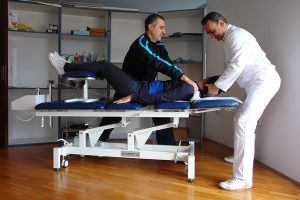Traction can be electronic and mechanic. It is mostly applied to the spine, spreading apart the vertebrae and applying suction to the protruding part of the discus. Seldom is it enough to use traction without manual medicine. We mostly combine the usage of traction and manual medicine. Traction is, just like manual medicine, also remarkable in prevention because it brings back the elasticity of the discuses and ligaments by repairing amortisation.
Of course, manual medicine also has a strong place in preventing damage by increasing the elasticity of the soft tissue. For example, in lumbar spine traction, the lumbar spine can be extended up to 0.5 centimetres (0.2 inches). The most frequent way of using such an extension is to perform the manual procedure immediately after. It is clear that the liquid that withdraws from the surrounding area with the extension of the spine into the discuses between the spine thus extending the space and distance between the vertebrae, returns back relatively quickly, just like the distance. A similar, although substantially smaller, phenomenon takes place in the morning. After a night’s sleep, we are 1-1.5 centimetres (0.4 – 0.6 inches) taller than we are in the evening. If we take into consideration the fact that resting while lying down followed by relaxing sleep is optimal, traction is not only a type of therapy but also a desirable type of relaxation for the spine or joints.


